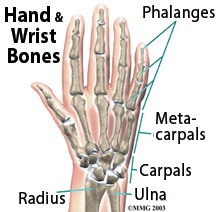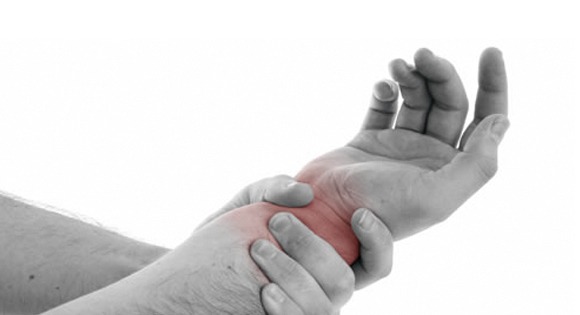What You Need to Know
Suzette Nynas, Ed.d, ATC , LAT – MSUB Athletic Training Program Director, Assistant Professor
What is the TFCC?
To begin the discussion regarding TFCC injuries, it is important for a quick review the anatomy of the wrist joint as well as the TFCC. The wrist joint is comprised of the ulna, the radius, 8 carpal bones as well as soft tissue (ligaments, muscles, cartilage, etc.). The TFCC is located on the ulnar aspect (pinky side) of the wrist and contains a cartilage disc, meniscus, and ligaments. Here the TFCC provides stability as well as helps the wrist absorb and/or redistributes forces that may be applied during certain activities.1 When an injury to the TFCC occurs, damage to the cartilage disc and meniscus ensues. 2
of the wrist joint as well as the TFCC. The wrist joint is comprised of the ulna, the radius, 8 carpal bones as well as soft tissue (ligaments, muscles, cartilage, etc.). The TFCC is located on the ulnar aspect (pinky side) of the wrist and contains a cartilage disc, meniscus, and ligaments. Here the TFCC provides stability as well as helps the wrist absorb and/or redistributes forces that may be applied during certain activities.1 When an injury to the TFCC occurs, damage to the cartilage disc and meniscus ensues. 2
Causes of a TFCC Injury
An injury to the TFCC can be as a result of either an acute or traumatic injury (class 1) or  overuse and degenerative condition (class 2).2 A common mechanism of injury (MOI) for an acute injury is a hyperextension injury, such falling on an outstretched arm trying to catch yourself when you fall or an offensive lineman blocking during a play.1 An example of an overuse MOI would be repetitive motion at the wrist due to swinging a bat or tennis racket,1,5 or any repetitive motions required for work or home activities. Degenerative or chronic damage to the TFCC can also occur. These degenerative changes often take place in conjunction diseases or disorders such as rheumatoid arthritis or gout.5 Those individuals who are at an increased risk of injuring their TFCC include athletes who perform closed kinetic chain activities where their body weight is absorbed by their shoulder, wrist, hand (i.e. gymnasts, wrestlers).1,2 Additionally, children and those individuals who have a longer ulna are also predisposed to injuries to the TFCC.1,2,5
overuse and degenerative condition (class 2).2 A common mechanism of injury (MOI) for an acute injury is a hyperextension injury, such falling on an outstretched arm trying to catch yourself when you fall or an offensive lineman blocking during a play.1 An example of an overuse MOI would be repetitive motion at the wrist due to swinging a bat or tennis racket,1,5 or any repetitive motions required for work or home activities. Degenerative or chronic damage to the TFCC can also occur. These degenerative changes often take place in conjunction diseases or disorders such as rheumatoid arthritis or gout.5 Those individuals who are at an increased risk of injuring their TFCC include athletes who perform closed kinetic chain activities where their body weight is absorbed by their shoulder, wrist, hand (i.e. gymnasts, wrestlers).1,2 Additionally, children and those individuals who have a longer ulna are also predisposed to injuries to the TFCC.1,2,5
Signs and Symptoms
The signs and symptoms of a TFCC injury are numerous. Some examples of such signs and symptoms include:
- Pain on the ulnar (pinky) aspect of wrist
- Pain with rotation (turning a door knob)
- Pain with bearing weight (push-ups)
- Decreased strength in grip
- Swelling
- Clicking sound with movement
- Catching sensation with movement
- Crepitus (crackling sound or sensation) and
- Joint instability 1, 2, 5
Evaluation and Diagnosis
An injury to the TFCC can be difficult to evaluate and diagnose and is often be mistreated as a routine wrist sprain.1,6 When a TFCC injury is suspected, it is imperative that the individual be seen and evaluated by an orthopedic physician. The orthopedic physician will perform special tests which moves and places stress on the TFCC during their physical examination. The physician may also order x-rays, an arthrography (x-rays with dye injected into area), an MRI, or an arthroscopy evaluation to confirm the diagnosis of a TFCC injury.2

Treatment
Either conservative or surgical treatment may be used to treat injury or damage to the TFCC. If the wrist is stable, conservative treatment is usually recommended.2 Conservative treatment usually consists of immobilization (splint or cast if severe), ice, anti-inflammatories and physical therapy or a home exercise program. A cortisone injection may also be prescribed by the physician2. Normally conservative treatment works well if the correct diagnosis is made early.6 However, if the wrist is unstable or if conservative management and treatment fails and results in continued pain and instability, surgical intervention is necessary. If surgery is deemed appropriate by the orthopedic surgeon, he/she will more often than not perform a debridement (clean out the joint) and if necessary repair damaged tissues and/or correct structural issues.2 Physical therapy will also be prescribed after surgical intervention to resolve pain, return to normal range of motion and function, as well as resume normal strength so as to return to sport, recreation, work and activities of daily living. 2,5
Long term implications such as pain, instability, and disability can result if a TFCC injury is not treated quickly and properly.1 Thus it is imperative that anyone who has a suspected TFCC injury to see a physician as soon as possible.1,5
References:
- Starkey, C, Brown, S, Ryan J. Examination of Orthopedic and Athletic Injuries. 3rd ed. Philadelphia: FA Davis; 2010.
- eOrthopod. A patient’s guide to Triangular Fibrocartilage Complex (TFCC) Injuries. Available at: www. http://www.methodistorthopedics.com/ triangular-fibrocartilage-complex-tfcc-injuries
- Wrist image. Available at http://www.eorthopod.com/sites/default/files/







